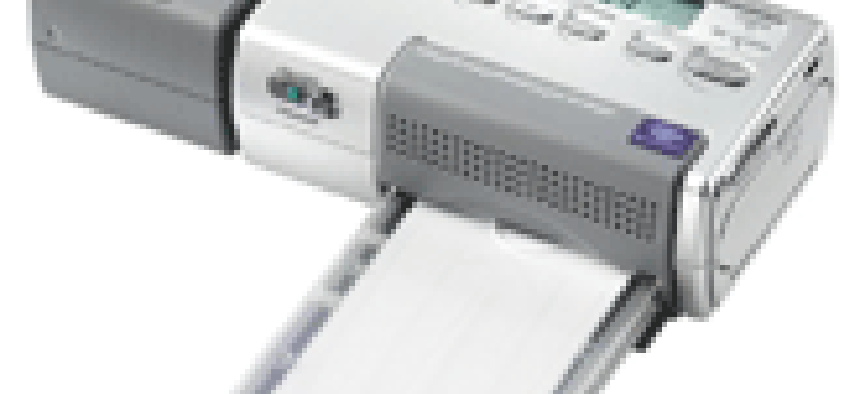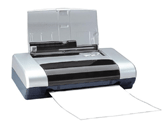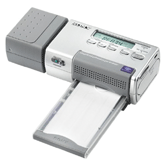If you travel enough, you'll run into situations where it would be pretty handy to have a printer in your knapsack.A 24-hour print shop might not be near the conference site where you're making an early morning presentation. And while many inexpensive motels will 'leave the light on for you,' they might not have a high-end fax machine capable of printing out documents in clear, plain-paper copies.In these circumstances and many others, you need a portable page printer.Portable printers typically can fit in a briefcase or overnight bag, weigh less than 4 pounds and can run on either 120V AC or battery power. Some have optional 12V car adapters.[IMGCAP(2)]The price for portability is reasonable enough, with most of the printers listed in the accompanying chart costing less than $400, not counting consumables.Portable printers use one of several basic technologies: ink-jet, thermal transfer, direct thermal and dye sublimation. Only one of the printers in the guide, O'Neil Product Development Inc.'s 8i, uses older dot-matrix impact technology, in which a revolving print head strikes the paper under a ribbon, as with a typewriter. This unit, installable in vehicles and designed for invoice printing, is a fairly specialized model and is not typical of the rest of the products listed.Ink-jets. Portable ink-jet printers, best represented by Canon U.S.A. Inc.'s BJC-55, i70 and BJC-85 Color Bubble Jet models, and Hewlett-Packard Co.'s deskjet 450cbi and 450ci, produce good images in both color and black and white. Like their larger desktop counterparts, portable ink-jets propel tiny drops of ink directly onto the page. The portables are certainly slower and not as well equipped as desktop printers, but the quality of their output should be acceptable to all but the most discerning users.Canon's $350 BJC-55 weighs just 2.1 pounds and produces crisp text and graphics at a rate of 5.5 pages per minute monochrome and 2 ppm color, with a resolution of 720 by 360 dots per inch. It handles letter, legal and A4 paper, and No. 10 envelopes. The printer has a 120V AC cable and lithium-ion battery.The BJC-55's Universal Serial Bus port enables fast and easy connection to both PCs and Apple Macintoshes, and its Fast IrDA infrared feature allows convenient wireless printing from Microsoft Windows-compatible printers and handheld devices. Its lithium-ion battery lets you print up to 100 pages before recharging.The options package for the BJC-55 includes an automatic sheet feeder for multiple-page documents, a sheetfed IS-12 color image scanner for scanning photos and documents, and the BC-12e photo ink cartridge for photo images.Hewlett-Packard's $350 deskjet 450cbi is a bit heftier than the BJ-55, weighing in at 4.6 pounds with battery. It prints at respectable speeds of 5 ppm black and 1.3 ppm color in normal mode, and maintains a crisp 1,200- by 1,200-dpi resolution. It handles a similar range of paper media to the BJC-55 and also has a 120V AC cable and lithium-ion battery.The deskjet 450cbi comes with a useful set of interfaces, including the IEEE 1284 bidirectional parallel interface, USB, Fast IrDA and Compact Flash Types 1 and 2 card slots. A 45-sheet feeder rounds out the unit's impressive features.Thermal transfer. Thermal transfer, also known as thermal heat fusion technology, uses heat and pressure to transfer images from a ribbon to the page. Simply put, the printer uses heat to melt the dry ink of various colors and presses the resulting images to the page. Citizen America Corp.'s Portable PN50, PN60 and PN60i typify printers that use this technology.[IMGCAP(3)]The $225 Portable PN60i weighs only 1 pound and prints at a rate of 2 ppm black and color at 360- by 360-dpi resolution. It will handle 8.5-inch by 11-inch paper, as well as transparencies and envelopes. A 120V AC cord and nicad battery is included with the base package, and a 12V DC car adapter is available as an option.The PN60i's standard interface is an IEEE 1284 bidirectional parallel connection, with options for IrDA infrared, RS-232C serial and Apple RS-422. An optional color cartridge for full-color printing is available, as are a Macintosh connectivity kit, serial interface cable and parallel interface cable.Direct thermal. Direct thermal technology is an offshoot of early fax technology and uses heat to set images on special heat-sensitive paper.Pentax Technologies Corp.'s $399 PocketJet II weighs less than 1 pound and can print letter-sized pages at 3 ppm with a resolution of 300 by 300 dpi. It handles letter, legal and A4 sheets or roll paper. A 120V AD cord, nicad battery and 12V car adapter is included in the package.The PocketJet II offers serial, parallel, USB and IrDA interfaces, and supports Windows, Windows CE, EPOC, Pocket PC, PalmOS and Blackberry operating systems. It will print 35 to 40 pages per charge.Dye sublimation. Dye sublimation is a relatively specialized print technology used for photo lab-quality pictures. Olympus America Inc.'s $380 P-200 and Sony Electronics Inc.'s $239 Digital Photo Printer MP1 are two portable units based on this technology. As these are photo printers, expect slow print speeds offset by high resolutions.What are the trade-offs among these technologies?There also are, of course, certain limitations you have to accept with any portable printer.Speed. They have small print engines, so portable printers are slower than desktop models. Ink-jets are the fastest.[IMGCAP(4)]Resolution. Ideally, any printer should have resolutions of 300 by 300 dpi or better. Photo printers require the highest resolutions if they are to render photolike images successfully.Paper handling. For most purposes, single-sheet feeding is OK though slow. A paper-handling option providing automatic feeding of 30 or more sheets is useful, but sheet feeders can detract from any printer's overall portability.Compatibility. Find out which operating systems and computers your portable printer will support before you buy it. A Windows-only unit is fine if you're sure that's all you'll ever need, but I'd ask for Mac OS compatibility, at least as an option, just to be sure.Options. Scanners, paper feeders, extra interface cables, wireless capability and 12V DC car adapters are useful for road warriors and generally don't cost much compared with the extra versatility they provide.Interfaces. The more interfaces the better. In a portable printer, these include IEEE 1284 bidirectional parallel, USB, IrDA infrared, 232C serial and 802.11b wireless interfaces.Memory. Even a portable printer must have enough RAM to print high resolutions. Find out if the RAM in the unit you're interested in can be upgraded and how much it will cost.Consumables. Factor in the cost of consumables, especially black and color ink cartridges or ink bars and paper. Ink-jet cartridges must be replaced frequently and can be costly. Specialized thermal paper can be very expensive.
Brother International's $300 MPrint is a direct thermal printer that weighs just more than a half-pound.
Canon's i70 Color Bubble Jet Printer uses ink-jet printing at photo-quality resolutions. It's priced at $250.
Hewlett-Packard's deskjet 450ci, priced at $300, can print at photo-quality resolutions on a variety of paper sizes.
Sony's $239 Digital Photo Printer MP1 uses dye sublimation to print on photo paper.
Give and take- Ink-jets generally provide better output than thermal transfer and thermal models.
- Thermal transfer and direct thermal printers are smaller, lighter and less complex than ink-jets.
- Direct thermal printers are less expensive than the others, but they are limited to monochrome output.
- Inexpensive portable dye sublimation printers are capable of producing good-quality images, but they are mainly photo printers and not especially well-designed for text.
J.B. Miles of Pahoa, Hawaii, writes about communications and computers. E-mail him at 









